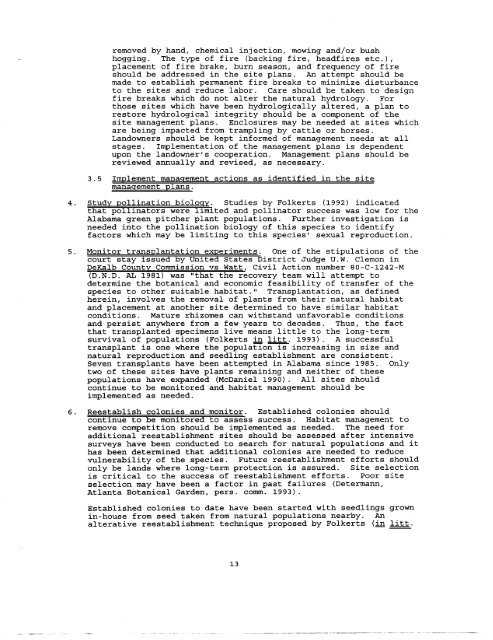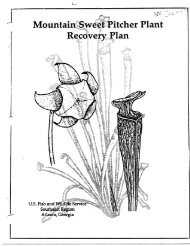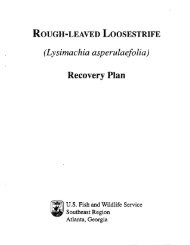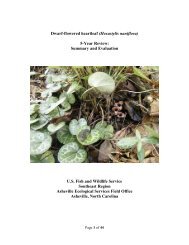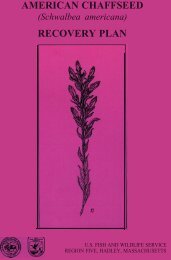Green Pl tcher Plant - Herbarium
Green Pl tcher Plant - Herbarium
Green Pl tcher Plant - Herbarium
Create successful ePaper yourself
Turn your PDF publications into a flip-book with our unique Google optimized e-Paper software.
.<br />
removed by hand, chemical injection, mowing and/or bush<br />
hogging. The type of fire (backing fire, headfires etc.),<br />
placement of fire brake, burn season, and frequency of fire<br />
should be addressed in the site plans. An attempt should be<br />
made to establish permanent fire breaks to minimize disturbance<br />
to the sites and reduce labor. Care should be taken to design<br />
fire breaks which do not alter the natural hydrology. For<br />
those sites which have been hydrologically altered, a plan to<br />
restore hydrological integrity should be a component of the<br />
site management plans. Enclosures may be needed at sites which<br />
are being impacted from trampling by cattle or horses.<br />
Landowners should be kept informed of management needs at all<br />
stages. Implementation of the management plans is dependent<br />
upon the landowner’s cooperation. Management plans should be<br />
reviewed annually and revised, as necessary.<br />
3.5 Implement management actions as identified in the site<br />
management plans<br />
4. Study pollination biology. Studies by Folkerts (1992) indicated<br />
that pollinators were limited and pollinator success was low for the<br />
Alabama green pi<strong>tcher</strong> plant populations. Further investigation is<br />
needed into the pollination biology of this species to identify<br />
factors which may be limiting to this species’ sexual reproduction.<br />
5. Monitor transplantation experiments. One of the stipulations of the<br />
court stay issued by United States District Judge U.W. Clemon in<br />
DeKalb County Commission vs Watt, Civil Action number 80-C-1242-M<br />
(D.N.D. AL 1981) was “that the recovery team will attempt to<br />
determine the botanical and economic feasibility of transfer of the<br />
species to other suitable habitat.” Transplantation, as defined<br />
herein, involves the removal of plants from their natural habitat<br />
and placement at another site determined to have similar habitat<br />
conditions. Mature rhizomes can withstand unfavorable conditions<br />
and persist anywhere from a few years to decades. Thus, the fact<br />
that transplanted specimens live means little to the long-term<br />
survival of populations (Folkerts in litt. 1993) . A successful<br />
transplant is one where the population is increasing in size and<br />
natural reproduction and seedling establishment are consistent.<br />
Seven transplants have been attempted in Alabama since 1985. Only<br />
two of these sites have plants remaining and neither of these<br />
populations have expanded (McDaniel 1990). All sites should<br />
continue to be monitored and habitat management should be<br />
implemented as needed.<br />
6. Reestablish colonies and monitor. Established colonies should<br />
continue to be monitored to assess success. Habitat management to<br />
remove competition should be implemented as needed. The need for<br />
additional reestablishment sites should be assessed after intensive<br />
surveys have been conducted to search for natural populations and it<br />
has been determined that additional colonies are needed to reduce<br />
vulnerability of the species. Future reestablishment efforts should<br />
only be lands where long-term protection is assured. Site selection<br />
is critical to the success of reestablishment efforts. Poor site<br />
selection may have been a factor in past failures (Determann,<br />
Atlanta Botanical Garden, pers. comm. 1993).<br />
Established colonies to date have been started with seedlings grown<br />
in-house from seed taken from natural populations nearby. An<br />
alterative reestablishment technique proposed by Folkerts (in litt<br />
13


